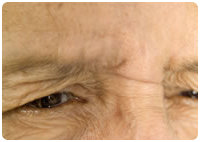|

Procedures
Upper Eyelid Drooping (Ptosis)
 |
 |
| Before |
After |
Ptosis (pronounced "toe-sis") is a condition where the upper eyelid droops over the eye. Congenital Ptosis is present at birth, and comprises a group of diseases in which the Ptosis is due to a developmental dystrophy of the levator muscle. Acquired Ptosis develops with age in adults.
The Ptosis may be mild in which the lid partially covers the pupil, or severe in which the lid completely covers the pupil. Ptosis can interfere with reading, and can lead to head and brow ache from straining to elevate your eyelids. Surgery to correct ptosis is commonly recommended in the preschool years to make it easier for children to see and to improve appearance. The type of surgery varies, depending upon how much the eyelids droop. Involutional ptosis develops with aging. It may worsen after other types of eye surgery or eyelid swelling. Ptosis may limit the field of of peripheral vision and produce an uneven appearance. Surgery corrects the problem by shortening the muscle that opens the eyelid. In adults, this surgery is done under local anesthesia. Only the eyelid is "frozen". There is nothing to see as the eyelids are closed shut during the surgery. Once the weak and slipped muscle is found and reattached to the eyelid, you will be asked to open and close your eyes. This may be repeated until I am happy with the height and contour of the elevated eyelid. The surgery is finished once we reach this point. The stitches usually dissolve in one week. There is a 5-15% chance that the muscle may stretch or overtighten after surgery. This may result in some unevenness in the result and can result in another smaller adjustment operation to get a better and more even result. The chance of having a second surgery is about 5%.
There is a one week recovery time with ptosis surgery. You will go home the same day as your operation but will need to rest and ice your eyelids every twenty minutes for the first two days. Only Tylenol is needed for discomfort which is usually minimal. The stitches will dissolve by themselves and the incision is usually not visible over the long term.
|